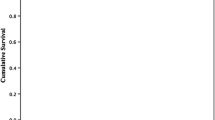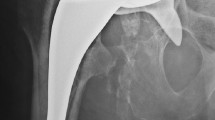Abstract
The concept of a dual articulation acetabular cup was developed by Prof. Bousquet in 1974. This concept has been shown to provide high stability after revision and primary total hip arthroplasty. The aim of our study was to evaluate the incidence of prosthetic instability in a consecutive homogeneous series of 384 primary dual mobility cups. Incidence of instability and implant survival were evaluated. Mean follow-up was 15.3 years (range, 12–20). There was no early or late instability. On the acetabular side there were 13 aseptic loosenings, 14 intraprosthetic dislocations, and seven polyethylene wear cases that required replacement of the liner. The cumulative survival rate of the dual-articulation acetabular cup using surgical revision for aseptic loosening as the endpoint was 95.9% ± 4.1% at 18 years postoperatively. Our series proves the good long term behaviour of dual-articulation acetabular components in primary arthroplasty. Their excellent survivorship rate and the absence of episodes of prosthetic instability increase our confidence in this concept.
Résumé
Le concept de cupule à double mobilité a été inventé par le Professeur Gilles BOUSQUET en 1974. Ce concept a permis de mettre en évidence une importante stabilité des hanches, notamment après révision mais également dans les prothèses totales de hanches de première intention. Le but de cette étude est d’évaluer l’incidence et l’instabilité sur une série homogène consécutive de 384 hanches traitées avec cupule à double mobilité. Le taux d’instabilité des implants sur les patients survivants a été évalué. Le suivi moyen a été de 15,3 ans (de 12 à 20 ans) au plus long recul, il n’y a aucune instabilité ni primaire, ni tardive. Par contre, il existe 13 descellements aseptiques acétabulaires, 14 luxations intra prothétiques, 7 usures du polyéthylène qui ont nécessité un remplacement du PE. Le taux de survie cumulé de cette cupule à double mobilité est de 95,9% ± à 18 ans si l’on prend comme critère la révision pour descellement aseptique. Cette série prouve le bon devenir à long terme de cette articulation dans les prothèses totales primaires, avec un excellent taux de survie et l’absence de phénomènes de luxation inhérentes à ce concept.





Similar content being viewed by others
References
Adam P, Farizon F, Fessy MH (2005) Dual articulation retentive acetabular liners and wear: surface analysis of 40 retrieved polyethylene implants. Rev Chir Orthop Reparatrice Appar Mot 91:627–636
Anderson MJ, Murray WR, Skinner HB (1994) Constrained acetabular components. J Arthroplasty 9:17–23
Berry DJ, von Knoch M, Schleck CD, Harmsen WS (2004) The cumulative long-term risk of dislocation after primary Charnley total hip arthroplasty. J Bone Joint Surg Am 86-A:9–14
Biedermann R, Tonin A, Krismer M, Rachbauer F, Eibl G, Stockl B (2005) Reducing the risk of dislocation after total hip arthroplasty: the effect of orientation of the acetabular component. J Bone Joint Surg Br 87:762–769
Burroughs BR, Rubash HE, Harris WH (2002) Femoral head sizes larger than 32 mm against highly cross-linked polyethylene. Clin Orthop Relat Res 150–157
Callaghan JJ, O’Rourke MR, Goetz DD, Lewallen DG, Johnston RC, Capello WN (2004) Use of a constrained tripolar acetabular liner to treat intraoperative instability and postoperative dislocation after total hip arthroplasty: a review of our experience. Clin Orthop Relat Res 117–123
Chandler RW, Dorr LD, Perry J (1982) The functional cost of dislocation following total hip arthroplasty. Clin Orthop Relat Res 168–172
Cooke CC, Hozack W, Lavernia C, Sharkey P, Shastri S, Rothman RH (2003) Early failure mechanisms of constrained tripolar acetabular sockets used in revision total hip arthroplasty. J Arthroplasty 18:827–833
Coventry MB (1985) Late dislocations in patients with Charnley total hip arthroplasty. J Bone Joint Surg Am 67:832–841
DeLee JG, Charnley J (1976) Radiological demarcation of cemented sockets in total hip replacement. Clin Orthop Relat Res 20–32
Farizon F, de Lavison R, Azoulai JJ, Bousquet G (1998) Results with a cementless alumina-coated cup with dual mobility. A twelve-year follow-up study. Int Orthop 22:219–224
Goergen TG, Resnick D (1975) Evaluation of acetabular anteversion following total hip arthroplasty: necessity of proper centring. Br J Radiol 48:259–260
Gruen TA, McNeice GM, Amstutz HC (1979) “Modes of failure” of cemented stem-type femoral components: a radiographic analysis of loosening. Clin Orthop Relat Res 17–27
Guyen O, Chen QS, Bejui-Hugues J, Berry DJ, An KN (2007) Unconstrained tripolar hip implants: effect on hip stability. Clin Orthop Relat Res 455:202–208
Kavanagh BF, Ilstrup DM, Fitzgerald RH Jr (1985) Revision total hip arthroplasty. J Bone Joint Surg Am 67:517–526
Kelley SS, Lachiewicz PF, Hickman JM, Paterno SM (1998) Relationship of femoral head and acetabular size to the prevalence of dislocation. Clin Orthop Relat Res 163–170
Levy RN, Levy CM, Snyder J, Digiovanni J (1995) Outcome and long-term results following total hip replacement in elderly patients. Clin Orthop Relat Res 25–30
Lewinnek GE, Lewis JL, Tarr R, Compere CL, Zimmerman JR (1978) Dislocations after total hip-replacement arthroplasties. J Bone Joint Surg Am 60:217–220
Livermore J, Ilstrup D, Morrey B (1990) Effect of femoral head size on wear of the polyethylene acetabular component. J Bone Joint Surg Am 72:518–528
Merle d’Aubigné R (1970) Cotation chiffrée de la fonction de hanche. Rev Chir Orthop Reparatrice Appar Mot 56:481–486
Philippot R, Adam P, Farizon F, Fessy MH, Bousquet G (2006) Survival of cementless dual mobility sockets: ten-year follow-up. Rev Chir Orthop Reparatrice Appar Mot 92:326–331
Tarasevicius S, Jermolajevas V, Tarasevicius R, Zegunis V, Smailys A, Kalesinskas RJ (2005) Total hip replacement for the treatment of femoral neck fractures. Long-term results. Medicina (Kaunas) 41:465–469
Woo RY, Morrey BF (1982) Dislocations after total hip arthroplasty. J Bone Joint Surg Am 64:1295–1306
Woolson ST, Rahimtoola ZO (1999) Risk factors for dislocation during the first 3 months after primary total hip replacement. J Arthroplasty 14:662–668
Yun AG, Padgett D, Pellicci P, Dorr LD (2005) Constrained acetabular liners: mechanisms of failure. J Arthroplasty 20:536–541
Author information
Authors and Affiliations
Corresponding author
Rights and permissions
About this article
Cite this article
Philippot, R., Camilleri, J.P., Boyer, B. et al. The use of a dual-articulation acetabular cup system to prevent dislocation after primary total hip arthroplasty: analysis of 384 cases at a mean follow-up of 15 years. International Orthopaedics (SICOT) 33, 927–932 (2009). https://doi.org/10.1007/s00264-008-0589-9
Received:
Revised:
Accepted:
Published:
Issue Date:
DOI: https://doi.org/10.1007/s00264-008-0589-9




